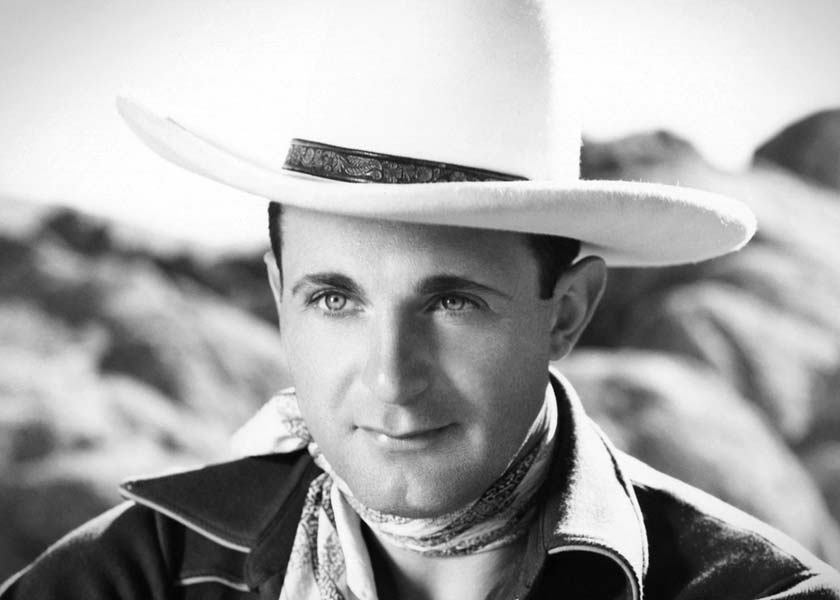Ape Man
Ray Corrigan was tall, muscular, and robust. On screen, he projected an easygoing, likeable personality. His impressive physical attributes made possible his Hollywood film career. In the early 1930s Corrigan was a physical culturist
(trainer) to movie stars. His usefulness as a stunt double and extra for the upcoming Tarzan movies was recognized by Cedric Gibbons, famous art director at MGM, and director of Tarzan and His Mate (1934). In Tarzan the Ape Man (1932) and Tarzan and His Mate, Corrigan did stunts and lumbered about in a gorilla suit as one of Tarzan's apes.
From 1932 to 1936, he did more stunt work in serials such as The Phantom Empire, acted small uncredited parts in She and Mutiny on the Bounty and appeared as several more apes (Naba the Gorilla in Murder in the Private Car, Bonga the Gorilla in Darkest Africa, and the orangopoid in the serial Flash Gordon).
In 1936, Corrigan signed with Republic Studios. His first starring part came the same year in the serial Undersea Kingdom. In this wonderfully fantastic serial, his amiable personality and imposing physical appearance compensate for his weak acting. His costumes fully display his striking physique.
B & Poverty Row Westerns
Corrigan's first Western, The Three Mesquiteers (1936), set the pattern of his Western career. He plays Tucson Smith, one of a trio of cowboy do-gooders helping farmers defend their land against a hostile rancher. At the end of the film, the friends ride away, looking for more adventures filled with opportunities to aid the little guy. Corrigan played Tucson Smith in 24 movies between 1936 and 1939, always as the second lead to the character Stony Brooke, played by Bob Livingston and later John Wayne. Tucson and Stony ride well, fight hard, shoot straight, and carry on a good natured rivalry, especially over the heroine.
In 1940, Corrigan took a step down in employment but made a step up in his position in the cowboy trio. He signed with Monogram Studios, a producing company of lower status than Republic Studios. In twenty The Range Busters series films, his character, named Ray Crash
Corrigan, is the lead member of the crime-fighting cowboy trio.
Corrigan's days as a cowboy hero ended in 1943, after more than forty series Westerns. The next fifteen years of his film career mirror his first years. He did some stunt work (Adventures of Sir Galahad), played a few small (mostly uncredited) parts, and appeared as more apes, such as the title characters of Nabonga, Zamba, and Bela Lugosi Meets a Brooklyn Gorilla. Corrigan's final role was the title character of It! The Terror from Beyond Space (1958), a major influence on Alien (1979).
Corriganville
In 1937, Corrigan bought a large 1500 acre ranch in the Simi Valley, about 30 miles north of Hollywood. He built a house and enjoyed his time there. The terrain was varied and picturesque, and Corrigan rented out the ranch as a movie location, especially for Westerns. By 1949, many buildings and other facilities had been built, and Corrigan opened the ranch as an amusement park, named Corriganville Movie Ranch. The park was successful, and Corrigan enjoyed greeting visitors and appearing in Western-themed shows.
Corrigan married in the early 1940s, and he and his wife, Rita, had three children. By 1954, the marriage was breaking up. Rita filed for a divorce. The contentious divorce had its dramatic aspects. In June, 1954, The Los Angeles Times reported that Corrigan and three detectives had burst into Rita's motel apartment and found her with another man, Moses Stiltz, who was the ex-foreman at the Corrigan ranch. The Times later reported an 80 miles per hour car chase between Corrigan and Stiltz which climaxed with both men threatening to file citizen's arrests charging assault with a deadly weapon. In court, Corrigan and his wife accused each other of having affairs with workers at the ranch.
After the divorce, Rita married Stiltz, and Corrigan married a young Western showgirl. Corrigan and his ex-wife continued to contest the settlement of their community property, including Corriganville. In 1963, they agreed to divide the $1.8 million proceeds from the sale of the ranch. Corrigan's second marriage also ended in divorce in 1967. Ray Corrigan was living in a mobile home in Brookings, Oregon, when he died in 1976. Corriganville Movie Ranch had closed in 1965.
Further Reading

